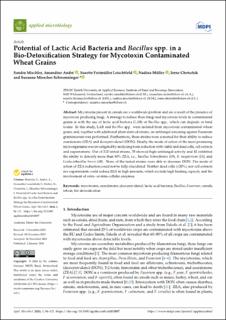Please use this identifier to cite or link to this item:
https://doi.org/10.21256/zhaw-29990| Publication type: | Article in scientific journal |
| Type of review: | Peer review (publication) |
| Title: | Potential of lactic acid bacteria and Bacillus spp. in a bio-detoxification strategy for mycotoxin contaminated wheat grains |
| Authors: | Mischler, Sandra André, Amandine Freimüller Leischtfeld, Susette Müller, Nadina Chetschik, Irene Miescher Schwenninger, Susanne |
| et. al: | No |
| DOI: | 10.3390/applmicrobiol4010007 10.21256/zhaw-29990 |
| Published in: | Applied Microbiology |
| Volume(Issue): | 4 |
| Issue: | 1 |
| Page(s): | 96 |
| Pages to: | 111 |
| Issue Date: | 2-Jan-2024 |
| Publisher / Ed. Institution: | MDPI |
| ISSN: | 2673-8007 |
| Language: | English |
| Subjects: | Cereals; Bio-detoxification; Zearalenone; Mycotoxins; Deoxynivalenol; Lactic acid bacteria; Bacillus; Fusarium; Wheat |
| Subject (DDC): | 664: Food technology |
| Abstract: | Mycotoxins present in cereals are a worldwide problem and are a result of the presence of mycotoxin producing fungi. A strategy to reduce these fungi and mycotoxin levels in contaminated grains is with the use of lactic acid bacteria (LAB) or Bacillus spp., which can degrade or bind toxins. In this study, LAB and Bacillus spp. were isolated from mycotoxin contaminated wheat grains and, together with additional plant-derived strains, an antifungal screening against Fusarium graminearum was performed. Furthermore, these strains were screened for their ability to reduce zearalenone (ZEA) and deoxynivalenol (DON). Finally, the mode of action of the most promising microorganisms was investigated by analyzing toxin reduction with viable and dead cells, cell extracts and supernatants. Out of 212 tested strains, 70 showed high antifungal activity and 42 exhibited the ability to detoxify more than 90% ZEA, i.e., Bacillus licheniformis (19), B. megaterium (13), and Levilactobacillus brevis (10). None of the tested strains were able to decrease DON. The mode of action of ZEA reduction could not be fully elucidated. Neither dead cells (<20%), nor cell extracts nor supernatants could reduce ZEA in high amounts, which exclude high binding capacity and the involvement of extra- or intra-cellular enzymes. |
| URI: | https://digitalcollection.zhaw.ch/handle/11475/29990 |
| Fulltext version: | Published version |
| License (according to publishing contract): | CC BY 4.0: Attribution 4.0 International |
| Departement: | Life Sciences and Facility Management |
| Organisational Unit: | Institute of Food and Beverage Innovation (ILGI) |
| Published as part of the ZHAW project: | Strategien zur Reduktion von Mykotoxinen in Getreidenebenproduktströmen |
| Appears in collections: | Publikationen Life Sciences und Facility Management |
Files in This Item:
| File | Description | Size | Format | |
|---|---|---|---|---|
| 2024_Mischler-etal_Potential-Lactic-Acid-Bacteria-Bacillus-spp_MDPI.pdf | 1.19 MB | Adobe PDF |  View/Open |
Show full item record
Mischler, S., André, A., Freimüller Leischtfeld, S., Müller, N., Chetschik, I., & Miescher Schwenninger, S. (2024). Potential of lactic acid bacteria and Bacillus spp. in a bio-detoxification strategy for mycotoxin contaminated wheat grains. Applied Microbiology, 4(1), 96–111. https://doi.org/10.3390/applmicrobiol4010007
Mischler, S. et al. (2024) ‘Potential of lactic acid bacteria and Bacillus spp. in a bio-detoxification strategy for mycotoxin contaminated wheat grains’, Applied Microbiology, 4(1), pp. 96–111. Available at: https://doi.org/10.3390/applmicrobiol4010007.
S. Mischler, A. André, S. Freimüller Leischtfeld, N. Müller, I. Chetschik, and S. Miescher Schwenninger, “Potential of lactic acid bacteria and Bacillus spp. in a bio-detoxification strategy for mycotoxin contaminated wheat grains,” Applied Microbiology, vol. 4, no. 1, pp. 96–111, Jan. 2024, doi: 10.3390/applmicrobiol4010007.
MISCHLER, Sandra, Amandine ANDRÉ, Susette FREIMÜLLER LEISCHTFELD, Nadina MÜLLER, Irene CHETSCHIK und Susanne MIESCHER SCHWENNINGER, 2024. Potential of lactic acid bacteria and Bacillus spp. in a bio-detoxification strategy for mycotoxin contaminated wheat grains. Applied Microbiology. 2 Januar 2024. Bd. 4, Nr. 1, S. 96–111. DOI 10.3390/applmicrobiol4010007
Mischler, Sandra, Amandine André, Susette Freimüller Leischtfeld, Nadina Müller, Irene Chetschik, and Susanne Miescher Schwenninger. 2024. “Potential of Lactic Acid Bacteria and Bacillus Spp. In a Bio-Detoxification Strategy for Mycotoxin Contaminated Wheat Grains.” Applied Microbiology 4 (1): 96–111. https://doi.org/10.3390/applmicrobiol4010007.
Mischler, Sandra, et al. “Potential of Lactic Acid Bacteria and Bacillus Spp. In a Bio-Detoxification Strategy for Mycotoxin Contaminated Wheat Grains.” Applied Microbiology, vol. 4, no. 1, Jan. 2024, pp. 96–111, https://doi.org/10.3390/applmicrobiol4010007.
Items in DSpace are protected by copyright, with all rights reserved, unless otherwise indicated.